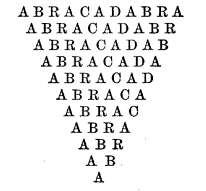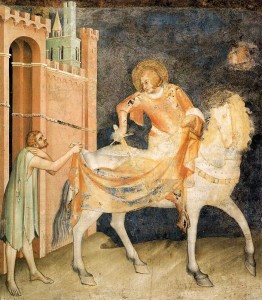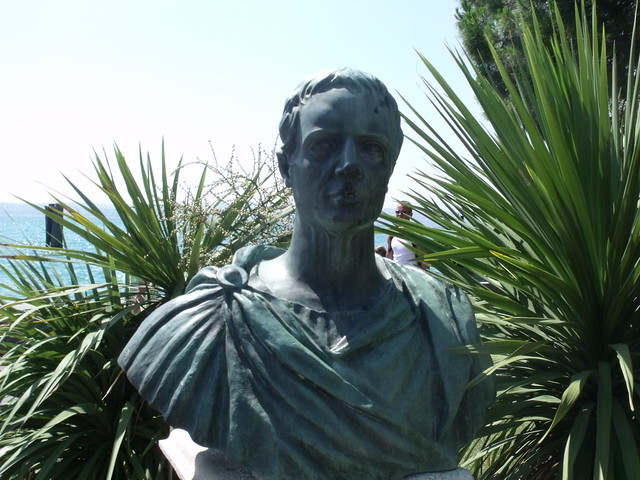Abracadabra
mortiferum magis est quod Graecis hemitritaeos
vulgatur verbis; hoc nostrā dicere linguā
non potuēre ulli, puto, nec voluere parentes.
inscribes chartae quod dicitur abracadabra
saepius et subter repetes, sed detrahe summam
et magis atque magis desint elementa figuris
singula, quae semper rapies, et cetera figes,
donec in angustum redigatur littera conum :
his lino nexis collum redimire memento.
nonulli memorant adipem prodesse leonis.
Quinctius Serenus Sammonicus, Liber Medicinalis 923-941 (ed. Vollmer in Corpus Medicorum Latinorum 3.2, Leipzig: Teubner, 1916). The work seems to date from the 2nd to the 4th centuries AD, and is usually assigned by scholars to around AD 200, based on the dubious identification of the author as Serenus Sammonicus, a scholar and moral critic of the age of Septimius Severus.
Vollmer sensibly suggests linques or scribes for figes, which he believes is a corruption carried over from figura in the previous line.
Here is my translation:
The malady the Greeks call hemitritaeos is more deadly. None of our ancestors could name this disease in our own language, nor did they feel the need to. On a piece of parchment, write the so-called “abracadabra” several times, repeating it on the line below; but take off the end, so that gradually individual letters, which you will take away each time, are missing from the word. Continue until the (last) letter makes the apex of a cone. Remember to wind this with linen and hang it around the neck. Many people say that the lard of a lion is effective . . .
Here is Daniel Defoe, in his (fictionalized) Journal of the Plague Year (1722):
But there was still another madness beyond all this, which may serve to give an idea of the distracted humour of the poor people at that time, and this was their following a worse sort of deceivers than any of these ; for these petty thieves only deluded them to pick their pockets and get their money, in which their wickedness, whatever it was, lay chiefly on the side of the deceivers deceiving, not upon the deceived. But in this part I am going to mention it lay chiefly in the people deceived, or equally in both, and this was in wearing charms, philtres, exorcisms, amulets, and I know not what preparations, to fortify the body with them against the plague ; as if the plague was not the hand of God, but a kind of a possession of an evil spirit, and that it was to be kept off with crossings, signs of the zodiac, papers tied up with so many knots, and certain words or figures written on them, as particularly the word Abracadabra, formed in triangle or pyramid, thus . . .

I might spend a great deal of time in my exclamations against the follies, and indeed the wickedness, of those things, in a time of such danger, in a matter of such consequences as this, of a national infection. But my memorandums of these things relate rather to take notice only of the fact, and mention only that it was so. How the poor people found the insufficiency of those things, and how many of them were afterwards carried away in the dead- carts and thrown into the common graves of every parish with these hellish charms and trumpery hanging about their necks, remains to be spoken of as we go along.







 A debate has been ongoing ever since vaping was introduced in the market. It might be that friends and family have their own opinions about this. Unfortunately, most of these opinions are based on myths and research and not based on evidence-based research. There is one thing that people believe in general. This is that vaping in moderation is much better than smoking cigarettes.
A debate has been ongoing ever since vaping was introduced in the market. It might be that friends and family have their own opinions about this. Unfortunately, most of these opinions are based on myths and research and not based on evidence-based research. There is one thing that people believe in general. This is that vaping in moderation is much better than smoking cigarettes.